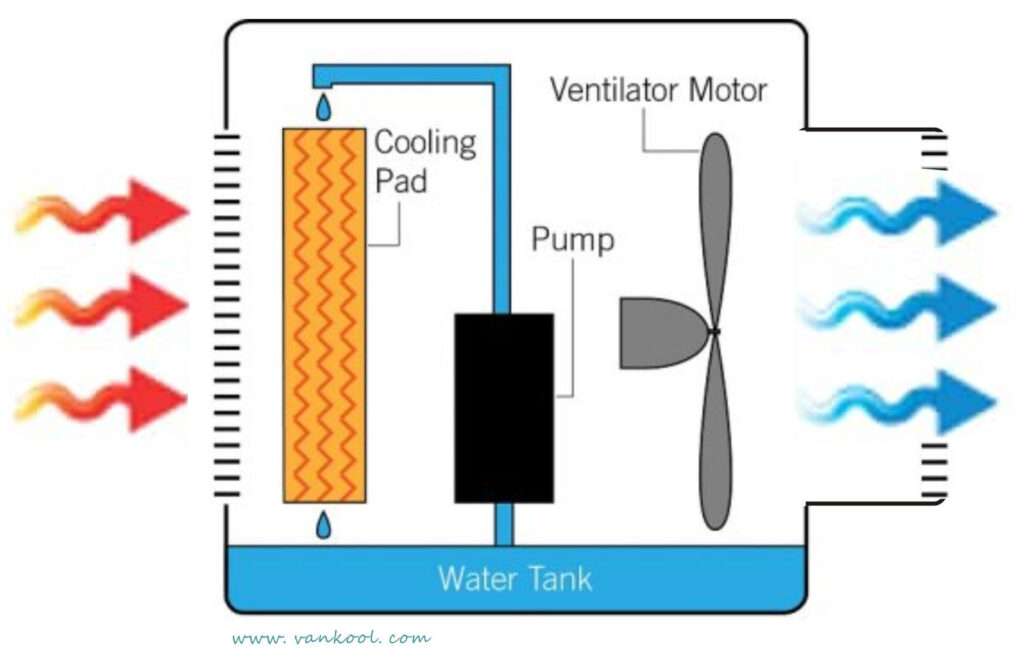Being in a Nevada prison in July without any cooling mechanisms sounds like cruel and unusual punishment to me, so I assume if this turns into a suit and that suit reaches SCOTUS, their ruling will be “go for it!”
Kind of related but here’s a video from Technology Connections if you want to learn more about swamp coolers and why they only work in specific conditions
Seriously tho… swamp coolers in the desert?
That’s where they work the best. Seriously.
While that is true in the sense that the lack of humidity allows for the evaporation to cool the air, a swampy running at peak efficiency cools the ambient air at best ~20°. If it’s 115, that’s still 95°. And that’s only if they are working perfectly, and they never are.
They’re also called evaporator coolers. I am not sure if the word swamp refers to it performing a function that might be found around a swamp or how they operate.

Maybe the pool of water at the bottom is referred to as a swamp.
I linked the video but it’s been a while since I watched it. I am not sure if he explains the nomenclature.
It’s because they smell like a swamp if you forget to clean them often enough. /S
Why the \s? What makes you so sure that isn’t the real reason?
If that isn’t the reason, then my guess would be that they’re called that because they increase the humidity of the room, making it feel like a swamp.
You need to put algaecide in the water supply, else eventually algae will grow in it.
Think of what you do with a swimming pool – algae doesn’t grow in that, even though it’s water in the direct sun – but a lot weaker.
A collection point for liquid drainage is called a “sump”.
Examples: A basement may have a low point in the foundation with a drainage pump installed to prevent flooding: a sump pump. Boats have a sump to collect onboarded water called a bilge. They’ve a bilge pump to remove the water.
Maybe “sump cooler” became “swamp cooler”?
Vance said there were various factors contributing to why the swamp coolers in two units at High Desert State Prison were no longer working – “hard water becoming corrosive, temperatures reaching so high the coolers are insufficient to combat the heat, and humidity reducing the effectiveness of the coolers.”
Evaporative coolers are more energy-efficient than air conditioners. However, they can only cool so far, because they rely on increasing humidity in air to reduce temperature. You can’t exceed 100%.
However, there are two ways an evaporative cooler can mitigate this.
The first is to use indirect cooling, and multiple stages.
The simplest form of evaporative cooling is to use direct cooling. This is basically a fan blowing across a wet filter, with the cooled air blowing at whoever you want to cool. That’s a single-stage evaporative cooler, a “direct” evaporative cooler. The downside is that this directly increases the humidity of the air that the person being cooled experiences. A more-sophisticated approach is to have two separate loops. You blow air past a filter, which cools it…but instead of blowing it at the person, you blow it into a heat exchanger – a countercurrent exchanger has theoretically 100% efficiency – and then back out to the outside. That cools the air in the other side of the heat exchanger without increasing its humidity. That’s an indirect evaporative cooler with two stages. You can then run that dry, cool air through another stage of an evaporative cooler to reduce the temperature further. In theory, you could have even more stages. Each individual stage’s cooling is limited by the difference between the current humidity and 100% humidity, but the system as a whole can exceed that.
The second is to use hybrid air-conditioning/evaporative cooler units. There, you use air conditioning…but the air blowing past the “hot” side’s radiator is cooled by an evaporative cooler, so you’re getting some of the energy efficiency benefits of evaporative cooling while still maintaining the ability to cool further than an evaporative cooler would.
I started to become increasingly-interested in evaporative coolers because I was totally oblivious to them as a kid – never seen them used, just air conditioners – but was impressed by their efficiency when I finally did run into them. I suspect that considerable portions of the US could probably dramatically reduce energy usage if affordable, reasonably-sophisticated evaporative coolers were used.
I am suspicious that part of the reason that they aren’t used more is because they’re easy to misuse – like, if not maintained, you can get algae growing in the things, and then they, well, smell like a swamp. But it shouldn’t cost much more to make one for continuous-flow systems that has a tank of concentrated algaecide and just slowly dispenses it.
I see lots of small, direct-cooling evaporative cooling systems for homes:
https://www.amazon.com/s?k=evaporative+cooler
These are inexpensive and don’t use much electricity, but are also kind of primitive affairs. You’re looking at basically a fan, a filter, a tank of water, and a pump in a box. One-stage, direct-cooling, so you must increase the humidity in the end-user’s environment. Algaecide addition needs to be done manually. At least the ones I’ve looked at don’t seem to have a “shut-down” phase to run fan-only to dry out the filter medium prior to storage, just tell the user to do so. For continuous-flow use (where you hook the thing up to a water supply, don’t need to fill it) only a single sensor to detect fill, which limits indoor, continuous-flow usage in houses (if you’re worried about failure of a sensor causing overfill and water damage; you can use them outdoors, but obviously, people would like to also use them indoors). No small hybrid air-conditioner/evaporative coolers; I’d think that this would be particularly interesting in a portable rather than window form factor, as one limitation of portable air conditioners is that they tend to have a certain amount of heat leakage through their hoses, even with dual-hose systems. But it’s pretty easy to make a moisture-proof barrier on an exhaust hose. On the portable ones I’ve looked at, no moisture sensor to auto-shut-off the pump if they’re being used in a non-continuous-flow environment; instead, the pump used has an anti-overheat shutoff, which means that the pump runs dry for at least a while, heats up, before cutting off, which isn’t ideal for pump longevity.
The fancier ones – hybrid, multi-stage – seem to only target larger, commercial installations, which kind of bums me out.
Another benefit – even if the energy efficiency alone doesn’t interest one – is that higher energy efficiency means that it becomes more-affordable to have higher air turnover with the outside, which means lower carbon dioxide levels indoors. One interesting finding that I don’t think gets enough attention is that we used to think that elevated carbon dioxide levels only have much of an impact when they get very high, quite some thousands of ppm. However, I’ve read some newer studies that show measurable cognitive decreases at considerably lower levels, like 1000 ppm. When you consider that carbon dioxide used to be ~280ppm pre-industrial era, is now over 420 ppm outdoors and rising at over 2 ppm per year, and that indoor air concentration is higher than outdoor air concentrations, not to mention in cities, the direct effects of higher carbon dioxide levels on humans start to become more interesting. As far as I’m aware, we have no existing carbon dioxide reduction process for buildings that’s more economical than just venting air to the outside. Modern buildings, which are better-sealed than older buildings, might come with the disadvantage of higher indoors carbon dioxide levels…so being able to cool efficiently so that higher turnover is practical is desirable.
Excellent write up and information, thanks! I too was oblivious to evaporative coolers when I was younger (grew up in a place with high humidity) and encountered them as an adult after moving to a drier place. They are surprisingly effective when maintained and conditions are right. I love the thought of using one to cool the AC radiator to increase capacity for cooling.







